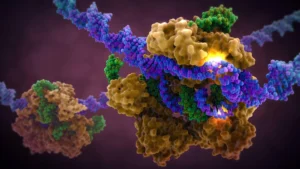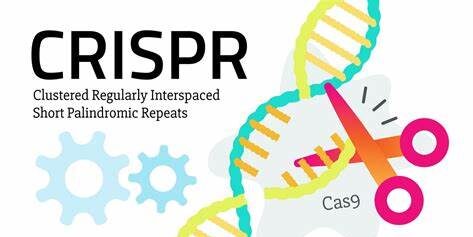Read time 6 minutes
Hopeful Science: Could CRISPR Help Me Heal?
First off—thank you, Universe. Every day I wake up, I feel blessed. Recovery is not linear, and neither is health, but both are worth fighting for. If you’re reading this blog, welcome to my world of reflection, resilience, and a whole lot of research.

This post explores a question that lives close to my heart. Can gene editing technologies like CRISPR help treat or cure the rare symptoms I live with?
Let’s take a look together.
The DNA Blueprint — What Is It?
Think of DNA like a giant recipe book written in a secret code, it tells your body how to grow, function, heal, and exist. Every human has this biological instruction manual inside their cells, helping control everything from eye color to immune response.
In scientific terms, DNA or deoxyribonucleic acid—is the building block of life. It’s how genetic information is stored and passed down. When something goes wrong in that blueprint, symptoms or even full-blown diseases can arise. But what if we could fix those errors directly?
That’s where gene editing comes into the picture.
Gene Editing Explained: Editing the Instruction Manual
Gene editing is a groundbreaking scientific method. It lets researchers change, remove, or insert sections of our DNA. Imagine fixing a typo in a word document—gene editing does that, but at a molecular level.
The goal? Correct genetic mistakes. Instead of masking symptoms, the dream is to target the root cause of disease.
Scientists use different techniques to do this. The most talked-about—and most promising—is CRISPR. But more on that soon!
Other tools include:
- Zinc finger nucleases
- TALENs
- Prime Editing (PE) — Searches and replaces specific DNA sequences.
- Base Editing (BE) — Swaps one DNA “letter” for another.
- RNA Editing — Alters RNA, the “messenger” that helps turn genetic instructions into proteins.
These innovations hold amazing potential. It’s not only to treat diseases but in some cases, possibly cure them.
My Health Journey: More Than One Diagnosis
In 2016, I was diagnosed with a condition so rare, most doctors hadn’t heard of it: Isaacs’ Syndrome. It’s a neuromuscular disorder that causes muscle hyperactivity—my muscles just don’t know how to relax.
Along the way, I also learned I had Lyme disease, a bacterial illness passed through tick bites. And as if that wasn’t enough, I’ve faced a cascade of other health challenges:
- Glaucoma, which damages the optic nerve
- Membranous Glomerulonephritis, a progressive kidney condition
- Severe digestive issues and low stomach acid
- Irritable Bowel Syndrome (IBS)
- Diabetes
- Frozen Shoulder
- Eczema
- Blood Pressure issues
Each diagnosis brought its own curveballs. I often wonder: Could gene editing offer answers, not just for me, but for millions battling rare conditions?
Let’s Talk CRISPR: The Gene Editing Star

CRISPR stands for Clustered Regularly Interspaced Short Palindromic Repeats. I know—science loves long names! But here’s what you need to know:
CRISPR is like molecular scissors. It cuts out faulty DNA and replaces it with corrected versions. It’s fast, accurate, and has taken the genetics world by storm.
Originally found in bacteria, CRISPR was used as a natural immune system, like a memory card against viruses. Scientists realized they could repurpose this system to fix DNA errors in humans, plants, and animals.
Two key components make CRISPR work:
- Cas enzyme (usually Cas9) — This is the scissor that snips DNA.
- Guide RNA (gRNA) — This part acts like a GPS, helping Cas9 find the exact location of the problem in the DNA strand.
Once it finds the error, it snips, replaces, and lets your body’s natural repair system do the rest. Magic, right?
Real-Life Uses of CRISPR
CRISPR is not just a theory—it’s already making waves across multiple industries:
- Medical breakthroughs — Scientists are using it to study genetic disorders, cancer, and even blindness
- Agriculture — Enhancing crop quality, improving drought resistance, and protecting plants from disease
- Probiotic engineering — Creating bacteria with superpowers to protect our gut health
- Gene studies — Researchers now have a powerful way to learn how genes function and interact
All of this means that CRISPR isn’t just a lab novelty—it’s the future.
Could CRISPR Help People Like Me?

Now, here’s the big question. Could CRISPR help with Isaacs’ Syndrome, or the many chronic conditions I live with?
At this stage, there’s no published research directly linking CRISPR to a cure for Isaacs’ Syndrome. But don’t lose heart—scientists are actively exploring CRISPR’s impact on neurological conditions.
Diseases that CRISPR might help tackle include:
- Parkinson’s
- Alzheimer’s
- Dementia
- Huntington’s Disease
- Dravet Syndrome
- Duchenne Muscular Dystrophy
The idea? Use gene editing to reverse or stop the progression of these illnesses. That might mean restoring brain function, protecting neurons, or repairing defective proteins.
Success Stories: CRISPR’s Early Wins

Let’s spotlight some real-world victories that offer hope:
- Sickle Cell Disease
In 2019, a patient saw life-changing improvements after receiving CRISPR-based treatment. This condition, caused by a single genetic mutation, was partially reversed.
- Blindness
Scientists have used CRISPR to treat a rare genetic form of blindness with promising results.
- Cancer
Clinical trials are targeting aggressive cancers, like those expressing the CD70 protein.
- Vision Loss
The University of Pennsylvania worked on a CRISPR-based therapy for Leber Congenital Amaurosis, a condition leading to complete blindness in children.
Each win is a signal that the impossible may soon be possible.
The Roadblocks: Challenges Ahead

CRISPR is powerful—but not perfect. Here are a few hurdles scientists still need to address:
- Off-target edits — Sometimes CRISPR accidentally changes parts of DNA it wasn’t supposed to.
- Delivery systems — Getting CRISPR into the right cells is still tricky.
- Immune response — Our bodies might reject the treatment as foreign.
- Incomplete edits — Not every cell may respond, which affects success.
- Unknown long-term effects — We don’t yet know what decades of gene edits might do.
- Ethical dilemmas — If we can enhance human genetics, where do we draw the line?
- These aren’t just technical challenges—they’re moral ones too. As technology races ahead, we need conversations about regulation, fairness, and consent.
My Takeaway: And It’s OK to Hope

Rare diseases are often invisible. They’re misdiagnosed, misunderstood, and underfunded. Living with one can feel like you’re speaking a language no one else knows.
But CRISPR offers a glimmer of hope—a possibility that science might one day understand us.
I’m not saying it’s a magic cure. It’s still early days. But for anyone feeling stuck or searching for answers, CRISPR shows that change is possible. If not today, then maybe tomorrow.
Let’s Keep Learning, Keep Advocating

Knowledge is a powerful medicine.
Whether you’re a patient, caregiver, student, or scientist, I encourage you to stay curious. Read up on breakthroughs. Ask questions. Share stories. The more we talk about rare conditions and gene editing, the closer we get to creating solutions.
Here’s where I’ve found valuable insights:
- CRISPR-Cas9-Mediated Gene Therapy in Neurological Disorders | Molecular Neurobiology (springer.com)
- CRISPR for neurodegenerative diseases: could it be a cure? (labiotech.eu)
- Four Success Stories in Gene Therapy (nature.com)
If you’ve made it this far, thank you. Your time and presence matter more than you know. Let’s continue raising awareness, embracing science, and walking toward better health.
Disclaimer
I’m not a doctor; these reflections are based on personal experience and do not constitute medical advice. Always consult your healthcare provider when exploring therapeutic options.


